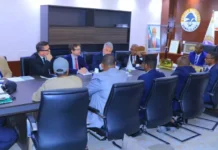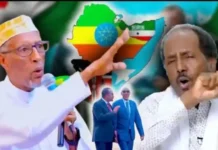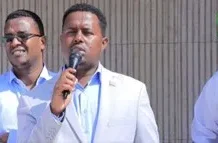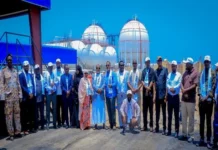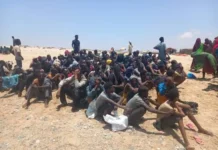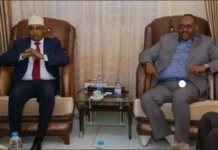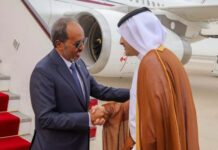Denied international recognition for nearly three decades, the breakaway republic has built a hybrid political system that some scholars term the first modern African democracy
“Never dress a deep wound superficially.” – Somali proverb At the recent London conference on Somalia, representatives from Somaliland were conspicuously absent, as they have been at all conferences on Somalia that have been taking place over the past two decades. Somaliland even boycotted the recent elections in Somalia, “even if it means stopping or destroying vehicles carrying ballot papers across the border,” as one Somalilander put it. This is because Somaliland does not consider itself as being part of Somalia; it views itself as a sovereign state, even though the international community has stubbornly failed to recognise it as such since it broke away from Somalia in 1991. Most Somalilanders are still haunted by the memories of May 1988, when President Siad Barre’s generals bombed northwestern Somalia, a stronghold of the opposition Somali National Movement, and killed thousands of people, mainly from the Isaaq clan. Memories of this massacre are the glue that holds Somalilanders together, like Jews whose memories of the Holocaust are never allowed to fade. A MIG FIGHTER JET IN HARGEISA THAT SAYS: NEVER FORGET Somalilanders will never let it get that bad again. That is why a Mig-15 fighter jet that was shot down during Barre’s carpet-bombing attacks has been permanently mounted as a public monument in a prominent square in Somaliland’s capital Hargeisa, a physical reminder of the atrocities committed, and a symbol of Somalilanders’ defiance. Yet, Somaliland offers important lessons on the governance models that can work in a strife-torn society divided along clan lines and where radical Islamist factions have taken root. Since it separated from Somalia, Somaliland has remained relatively peaceful, unlike its southern neighbours, and has its own government and institutions that have brought a semblance of normality to this troubled region. When Somaliland gained independence from Britain in 1960, it opted to unite with the newly independent Somali Republic (which after the Second World War had become a UN trusteeship under Italian administration). In 1991, it decided to forge its own path and disassociate from the dysfunction that marked both the latter part of Barre’s regime and the warlordism that replaced it. (Somaliland claims that since no legislation was passed to officially unite this former British protectorate with Somalia, it has every right to reclaim its territory.) It adopted a unique hybrid system of governance that incorporates elements of traditional customary law (known as xeer), Sharia law and modern secular institutions, including a parliament, a judiciary, an army and a police force. The Guurti, the upper House of Somaliland’s legislature, comprises traditional clan elders, religious leaders and ordinary citizens from various professions who are selected by their respective clans. Hargeisa adopted a unique hybrid system of governance that incorporates elements of traditional customary law (known as xeer), Sharia law and modern secular institutions, including a parliament, a judiciary, an army and a police force The Guurti wields enormous decision-making powers and is considered one of the stabilising factors in Somaliland’s inclusive governance model. Michael Walls, the author of A Somali Nation-State: History, Culture and Somaliland’s Political Transition, has described Somaliland’s governance model as “the first indigenous modern African form of government” that fuses traditional forms of organisation with those of representative democracy. Incumbent President Ahmed Silanyo came to power in 2010 following elections that were considered free and fair by international observers. In 2001, 97% of Somalilanders voted for a Constitution that declared Somaliland an independent nation. Unlike Somalia, Somaliland also has a well-resourced security apparatus, one that has successfully warded off Al Shabaab, the terrorist organisation that lays claim to much of southern and central Somalia, and which in recent weeks has carried out several suicide bombings in Mogadishu and attacked Kenya Defence Force bases in areas along the Kenya-Somalia border. Somaliland’s road to nation-building has been long and messy, and has witnessed many of the clan divisions and feuds that characterise Somali politics, albeit on a lesser scale than those in Somalia, as the dominant Isaaq clan has remained fairly united. As Walls, notes, voting systems, such as the open lists used in elections, tend to exacerbate these divisions, but they are only a small part of Somaliland’s discursive politics. Somaliland’s governance model is based on a system that is prevalent in many parts of Somalia, but which has been dismissed as undemocratic by proponents of Western-style democracy. The reality is that much of Somalia since the fall of Barre has been self-governing using a mix of clan-based systems, Sharia law and customary xeer administered by traditional elders. As public institutions collapsed or became dysfunctional, traditional governance systems, such as xeer and Sharia law, became more important. According to Ken Menkhaus, a professor of political science at Davidson College in North Carolina, these informal governance systems filled a governance vacuum after the collapse of the Somali state in 1991 and some, such as those adopted in Somaliland, have incorporated some elements of Western-style democracy, including independent secular institutions. By adapting governance to local cultures and traditions, Somaliland may just provide a sustainable governance model that could be replicated throughout Somalia. WHAT IS THE ALTERNATIVE? Those who argue that Somaliland is a spoiler in Somalia’s dream of a united country fail to recognise that the government in Mogadishu doesn’t offer much of an alternative – and lacks credibility in the eyes of many Somalis, particularly Somalilanders. Current President Mohamed Abdullahi “Farmajo” and his predecessors were not elected through a nation-wide referendum or general election but through a highly corrupt system that allowed selected clan elders to form “electoral colleges” that cast the vote. Besides, Farmajo’s authority, like his predecessors’, does not extend much beyond Mogadishu since most of the country is still controlled by clan-based fiefdoms or Al Shabaab. His and his predecessors’ governments have been viewed by many Somalis as Western-backed processes established to please the international community and to create the illusion of a Western-style democracy in Somalia. A former diplomat believes the rain started beating Somalia when ‘urban, corrupt, treacherous, power hungry, selfish, unpatriotic and unscrupulous’ faction leaders replaced ‘rural, apolitical, straightforward, morally upright’ traditional elders The bitter truth is that the majority of Somalia’s people have not experienced the benefits of a strong government or democratic institutions for more than 20 years; the concept of a state that delivers services to the people has remained a mirage for most residents living outside Mogadishu, especially in remote areas where the only system of government is customary law or Sharia. Services, such as health and education, are provided by various foreign foundations and non-governmental organisations or the private sector. (For example, Mogadishu University is funded by a Qatari foundation. Many hospitals and schools are similarly funded by foreign, mostly Arab, governments or religious organisations. State institutions, such as the Central Bank and revenue collection authorities, are non-existent or dysfunctional. It is believed that most of the revenue collected by past governments, for example, from the port of Mogadishu, was regularly diverted by senior government officials for personal use. Ironically, with its strict codes and hold over populations through systems of “tax collection” or “protection fees” combined with service delivery, Al Shabaab offers a semblance of “governance” that the government in Mogadishu has been unable to provide. Even when African Union (Amisom) forces liberate regions from the clutches of Al Shabaab, they essentially leave behind a governance vacuum that neither the Federal Government of Somalia nor the emerging regional administrations can fill. This has made these regions more prone to clan-based conflicts, which are apparent already in Jubbaland, where some members of the marginalised Bantu/Wagosha minority group have taken up arms in response to what they perceive to be a form of “ethnic cleansing” by both Al Shabaab and the new Ogaden-dominated Jubbaland administration of the Kenya-backed Ahmed Madobe (who was once a member of Al Shabaab) and the radical Islamic militia Hizbul Islam led by Sheikh Hassan Dahir Aweys). Kenya brought Madobe into its fold when it joined forces with the latter’s Ras Kamboni militia to invade Somalia in October 2011; it is believed that this merger was prompted by Nairobi’s desire to have a proxy Kenya-friendly administration in Jubbaland and by Madobe’s desire to reclaim the lucrative port of Kismayo. A CABINET OF ROGUES All of Somalia’s post-Barre governments have thus failed to re-establish state institutions that were destroyed during the civil war or to deliver services to the Somali people, though President Farmajo has promised to reverse this trend. In its entire eight-year tenure, from October 2004 to August 2012, the Transitional Federal Government (TFG) did not have the capacity to become a fully functioning government, with a fully fledged revenue collecting authority and robust ministries. Ministers had no portfolios and ministries had skeletal staff. The national army was weak and underfunded, and since 2007, the government has relied almost exclusively on African Union soldiers for security, though there have been attempts to revive the Somali National Army. The various TFG leaderships often gave former warlords ministerial positions on the assumption that political power would placate them. This resulted in what the former Somali diplomat Ismail Ali Ismail calls “a Cabinet of rogues”. Ismail believes that the rain started beating Somalia when “urban, corrupt, treacherous, power hungry, selfish, unpatriotic and unscrupulous” faction leaders replaced “rural, apolitical, straightforward, morally upright” traditional elders. The former remained immune to the destruction and displacement that conflict unleashed on the Somali people, who lived as internally displaced persons in their own country or as refugees in neighbouring countries. Farmajo’s attempts to build a strong and united Somalia may not bear much fruit as much of Somalia still suffers from a “trust deficit”; the country is still plagued by clan conflicts and many people do not want to risk having the kind of highly centralised government that was prevalent during Siad Barre’s regime. The Qatar-based Somali analyst Afyare Elmi proposes a “decentralised unitary system,” rather than what he calls the “clan-federalism” proposed and supported by the international community. In this system, sovereignty and constitutional powers would remain within the central government, while administrative, political and fiscal powers would devolve to different entities and regions. This would lead to a “de-concentration of authority” that is more responsive to local needs. Although Barre is credited with many progressive reforms, such as expanding literacy and women’s rights, he failed to bring about democracy in Somalia, and is also blamed for pitting clans against each other through favouritism, political patronage and persecution of certain clans There has been some debate on which type of governance model is most suitable for a country that is not just divided along clan/regional lines, but where political/militant Islam and lack of functioning secular institutions threaten nation-building. Federalism, or regional autonomy within a single political system, has been proposed by the international community as the most suitable system for Somalia as it caters for deep clan divisions by allocating the major clans semi-autonomous regional territories. But so far, it doesn’t look like it is working because Somalia remains fragmented at so many levels that even federal states cannot offer much-needed unity. The 4.5 political arrangement used for parliamentary and government allocation of seats, which gives power to the four largest clans (Darod, Hawiye, Dir and Rahanweyne), and (0.5) minorities does acknowledge the reality of a clan-based society, but as Somalia’s recent history has shown, clan can be, and has been, manipulated for personal gain by politicians. As dominant clans seek to gain power in a federated Somalia, there is a danger that the new federal states will mimic the corruption and clannism that has prevailed at the centre, which will lead to more competition for territories among rival clans and, therefore, to more conflict. This is one among many reasons why Somaliland is not keen to be part of Somalia. Besides, the various federal states that are emerging in Somalia under the new Constitution may end up as clan enclaves that are disconnected from the centre, and which actually work to undermine the central government in Mogadishu. Fears that entrenched clan interests will dominate the future political landscape in Somalia have generated heated debates about whether a unitary system is more suited to a country that is so divided and where minority groups have been denied a say in national politics for decades. Thus the vision of a united Somalia under one strong central government that dispenses security and services and distributes national resources equitably across the country, remains a dream. A PATCHWORK OF SEMI-AUTONOMOUS TERRITORIES Several experts have also proposed a “building block approach,” whereby the country would be divided into six “local administrative structures” that would eventually “resemble a patchwork of semi-autonomous territories defined in whole or in part by clan affiliation.”. In one such proposed model, the Isaaq clan would dominate the former British Somaliland in the northwest; the Majerteen in present-day Puntland would dominate the northeast; the Jubbaland and Gedo regions bordering Kenya would have a mixture of clans (though there are now fears that the Ogaden, who are politically influential along the Kenya border, would eventually control the region); a Hawiye-dominated polity would dominate central Somalia; the Digil-Mirifle would centre around Bay and Bakol; and Mogadishu would remain a cosmopolitan administrative centre. Some analysts argue that the proposed federalism will eventually lead to the balkanisation of Somalia as clan-based fiefdoms start competing for more resources and territories. Other critics, such as the US-based Somali scholar Abdi Samatar, have argued that federalism would lead to “institutionalised discrimination” against minority clans and groups, which would undermine national unity, citizenship and meritocracy. There is also a concern that the larger (armed) clans would manipulate the system, entrench corruption and pursue their political elites’ agendas at the expense of the Somali people. Observers say that one of the biggest dangers of an exclusionary political system is that rent-seeking and the grabbing of the spoils of war that have dominated Somali politics for so long may be replicated at the federal state level. HALF-BAKED DEMOCRATIC CULTURE Many people, including Somalis, believe that Somalia will take years before it has a functioning government because the country has little experience in representative democracy and because recent attempts to revive a democratic culture are coming a little too late. Somalia’s relatively peaceful and democratic first decade after Independence was abruptly ended by the assassination of President Abdirashid Sharmarke in 1969, just two years after he had taken over from the first post-Independence president, Adan Abdulle Osman (also known as Adan Adde). Barely a week later, Siad Barre gained control over Somalia through a bloodless military coup. Barre suspended the constitution, dissolved parliament, banned political parties and nationalised the economy. Parliament was replaced by the Supreme Revolutionary Council, the ultimate decision-making authority in the country. Although Barre is credited with many progressive reforms, such as expanding literacy and women’s rights, he failed to bring about democracy in Somalia, and is also blamed for pitting clans against each other through favouritism, political patronage and persecution of certain clans. His failures and weaknesses set the stage for his ouster in 1991 by the United Somali Congress led by Mohammed Farah Aideed and Ali Mahdi, who, depending on whom you ask, are either seen as heroes who liberated Somalia from the clutches of a dictator, or brutal warlords who unleashed violence and lawlessness in the country. Some argue that state-building efforts in Somalia have been hampered by a “pastoral ethos” characterised by competition, inter-clan rivalry, disdain for authority (except for traditional elders and religious leaders) and a deep mistrust and suspicion of outsiders. In his seminal book A Pastoral Democracy, first published in 1961, I.M. Lewis claimed that Somali society lacked “the judicial, administrative, and political procedures that lie at the heart of the Western conception of government.” I.M Lewis and other Western anthropologists fail to recognise that other pastoralist societies have successfully adopted modernisation and democracy and that blaming pastoralism for Somalia’s woes is to assume that Somali society is static and incapable of reinventing itself While acknowledging the importance of kinship and clan loyalty in the political organisation of traditional Somali society, Lewis was pessimistic about whether these could deliver Western-style democracy to Somalia. In Somalia’s lineage politics, he argued, “The assumption that might is right has overwhelming authority and personal rights… even if they are not obtained by force, can only be defended against usurpation by force of arms.” Critics of this “Somali exceptionalism” thesis argue that Lewis and other Western anthropologists fail to recognise that other pastoralist societies have successfully adopted modernisation and democracy and that blaming pastoralism for Somalia’s woes is to assume that Somali society is static and incapable of reinventing itself. SECRETIVE DEALS: THE OIL FACTOR There are fears that the secretive contracts between the Somali government and foreign oil companies could further sabotage Somalia’s institution-building efforts. There is widespread suspicion that oil looms large in Britain’s dealings with the Somali government, and that the former may be willing to overlook corruption and bad governance in the latter in order to preserve its economic interests. Somaliland and the semi-autonomous Puntland, have also been granting licences to oil companies without any reference to the central government in Mogadishu. Already, competition over an oil block that stretches across Somaliland and Puntland has increased tensions in these regions. These tensions indicate that in the absence of agreed-upon legal frameworks, the oil factor is likely to be a source of conflict in Somalia’s oil-producing regions in the near future. If Somaliland and its arch-enemy Somalia do not handle these oil deals in a transparent manner, there is a risk that peace in the Horn of Africa’s most fragmented region may remain elusive for many more years. However, Somaliland’s governance system, which tends to be consensual and inclusive, rather than prescriptive, may avoid the “resource curse” that has afflicted so many African countries. There are many more checks and balances in Somaliland’s hybrid system of tri-party democracy and traditional clan-based governance than in the governance model adopted by the Federal Government of Somalia. Which is not to say that Somaliland’s governance model is perfect; fear of conflict emerging from clan rivalries has led to the repression of the media and the consensual clan-based politics has hindered issue-based politics, eroded individual rights and led to the perception that some clans, such as the dominant Isaaq clan, are favoured over others. Tensions across its eastern border with Puntland also threaten the future stability of Somaliland. Somaliland’s strong economic ties with Ethiopia are also viewed with suspicion by the Somalia government, though it is no secret that the TFG often invited Ethiopia to quell insurgencies and to oust the Islamic Courts Union (some remnants of which morphed into Al Shabaab) from Mogadishu in 2006. There are fears that if recognised as an independent nation, Somaliland, like South Sudan, may experience clan-based conflicts that will undermine peace and democracy. However, Somaliland is unlikely to repeat the mistakes made by South Sudan’s myopic leaders Nonetheless, Somalilanders are unlikely to put their faith in a Mogadishu-based leadership, even if it is at the expense of not gaining international recognition as an independent state. The pan-Somali vision of a “Greater Somalia” that prompted this former British protectorate to unite with the newly independent Somali Republic in 1960, and which saw Siad Barre go to war with Ethiopia to claim the Ogaden region in 1977, vanished long ago. There are fears that if recognised as an independent nation, Somaliland, like South Sudan, may experience clan-based conflicts that will undermine peace and democracy. However, Somaliland is unlikely to repeat the mistakes made by South Sudan’s myopic leaders because, as Walls, points out, “The attributes that have served Somaliland so well until now are likely to continue to do so in the future – these are pragmatism and flexibility, coupled with an understanding of the past and an eye on the desired goals of the future.” International recognition of Somaliland could go a long way in achieving some of these goals.
By Rasna Warah


